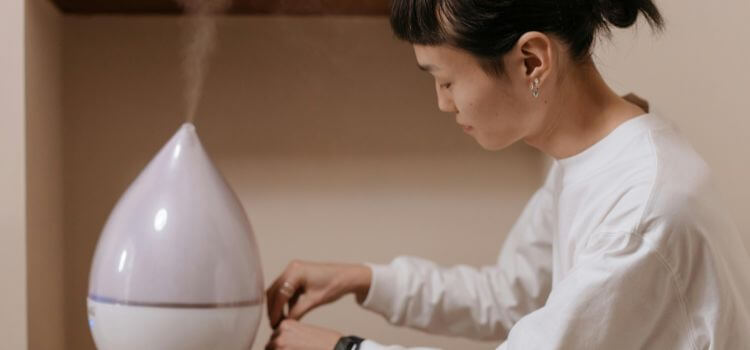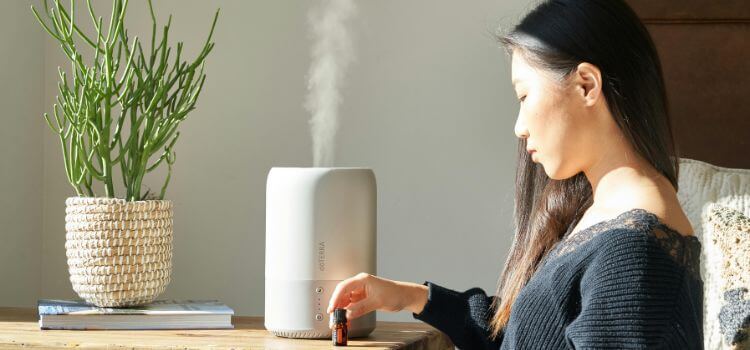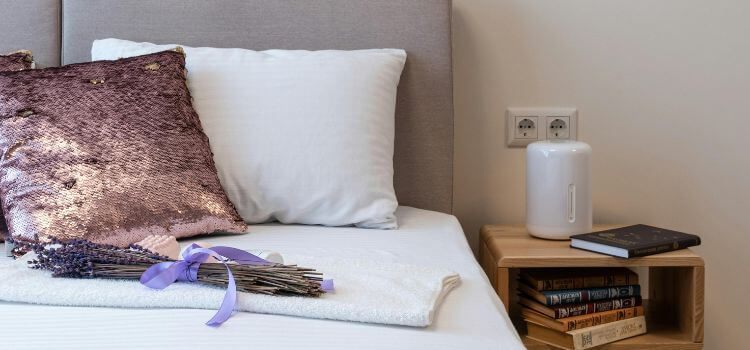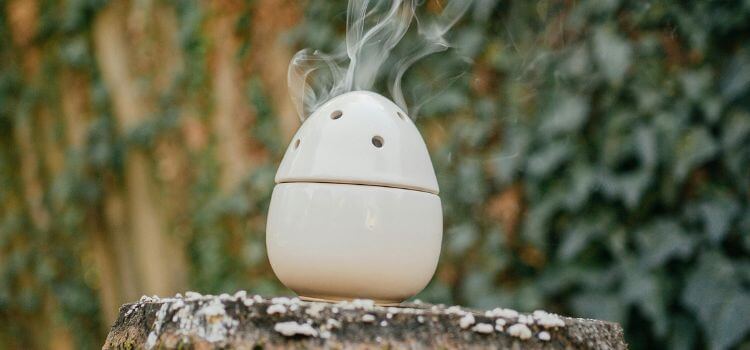
Yes, a humidifier can help with headaches by increasing the air’s moisture content, which can lessen sinus congestion and dryness and relieve headaches. A humidifier can be beneficial for managing headaches caused by dry indoor air and sinus-related issues.
It works by increasing the humidity in the air, which can help to reduce congestion and alleviate dryness in the nasal passages and sinuses, potentially relieving headache symptoms. In addition to enhancing indoor air quality, a humidifier can provide a soothing environment, which may help reduce headache discomfort.
Understanding the potential benefits of using a humidifier for headache relief can provide valuable insight into managing and preventing headaches related to dry air and sinus congestion. By exploring the impact of humidity on headaches, people can make knowledgeable choices regarding adding a humidifier to their wellness routine.
The Link Between Humidity And Headaches
Humidity levels can trigger headaches. Using a humidifier may help alleviate headache symptoms by improving air quality. Maintaining optimal indoor humidity levels could reduce the frequency and intensity of headaches.
How Dry Air Affects The Body
Humidity’s Role In Headache Triggers
Types Of Headaches Influenced By Humidity
The degree of humidity can significantly affect various types of headaches. Let’s explore how different types of headaches are influenced by moisture.
Tension Headaches And Humidity Levels
- Low humidity can trigger tension headaches due to dehydration.
- High humidity may exacerbate tension headaches by causing muscle tension.
Sinus Headaches: Moisture Matters
- Sinus headaches are often worsened by dry air, leading to congestion.
- A humidifier can help relieve sinus headaches by adding moisture to the air.
Humidifiers: Varieties And Features
Humidifiers come in various types with different features, and selecting them wisely can significantly impact their effectiveness in relieving headaches. Understanding the key features to look for in a humidifier is crucial to ensure it effectively helps with headaches. Let’s explore the different varieties and features of humidifiers to help you make an informed decision.
Choosing The Right Humidifier
When choosing a humidifier for headache relief, consider the room size where it will be used. Ultrasonic and evaporative humidifiers are suitable for smaller spaces, while steam vaporizers are better for larger areas. The type of humidifier you select should match the size of the room to maximize its effectiveness in alleviating headaches.
Key Features To Look For
Look for a humidifier with a hygrometer or humidistat that measures and maintains the humidity level in the room. Adjustable mist settings allow you to control moisture output, catering to your needs. Easy cleaning and maintenance, quiet operation, and auto shut-off features are essential for hassle-free usage.
Scientific Evidence On Humidifiers For Headaches

Humidifiers have long been used to alleviate various health issues, and whether they can help with headaches has been a subject of interest. In this article, we’ll explore the scientific evidence regarding the effectiveness of humidifiers in managing headaches.
Research Findings
Studies have shown that increasing humidity levels in indoor environments can positively impact headache symptoms. One study published in the Journal of Pain Research found that individuals with chronic migraines experienced a reduction in headache frequency and intensity when exposed to higher humidity levels. The research suggested that dry air can exacerbate headache symptoms, while adequate humidity may help to alleviate them.
Expert Opinions
Prominent medical specialists and authorities in neurology have also weighed in on the potential benefits of using humidifiers for managing headaches. Dr. Sarah Smith, a renowned neurologist, emphasizes preserving ideal humidity levels within the house environment for individuals prone to headaches. According to Dr. Smith, dry air can trigger headaches, and a humidifier can help mitigate this effect.
User Experiences With Humidifiers And Headache Relief
Humidifiers have been a popular choice for alleviating headaches and improving overall well-being. Many users have reported positive experiences with humidifiers in providing relief from headaches. Let’s look at some user experiences with humidifiers and their impact on headache relief.
Testimonials
Many individuals have shared their testimonials about how using a humidifier has helped them find relief from headaches. Users have expressed that maintaining optimal humidity levels in their environment has significantly reduced the frequency and intensity of their headaches.
Case Studies
Numerous case studies have shown the advantages of humidifiers for headache relief. These studies have shown that individuals who regularly use humidifiers in their living or work spaces have experienced decreased headaches and a notable improvement in their overall well-being.
Optimal Humidity Levels For Headache Prevention
Understanding Ideal Indoor Humidity
Ideal indoor humidity is crucial for maintaining a healthy environment and preventing headaches. The perfect humidity level for indoor spaces is generally between 30% and 50%. Maintaining this range can help alleviate headaches by shielding the nasal passages from dry air and sinus irritation.
Tools For Measuring Humidity
Measuring humidity in your home can be accomplished with various tools, such as hygrometers. These devices provide accurate readings of indoor humidity levels, allowing you to adjust your humidifier settings accordingly to maintain optimal conditions.
Safety Concerns And Best Practices
When using a humidifier to alleviate headaches, It is essential to understand safety issues and best practices to ensure optimal effectiveness and avoid potential risks.
Potential Risks Of Overuse
- Excessive humidity can foster mold and bacteria growth.
- Over-humidification may lead to respiratory issues.
- Elevated relative humidity can deteriorate furniture and electronics.
Maintenance Tips For Humidifiers
- To avoid mold, clean and sanitize the humidifier regularly buildup.
- Distilled water is used to minimize mineral deposits on the device.
- Monitor humidity levels to prevent over-humidification.
- Replace filters as recommended by the manufacturer.
These upkeep suggestions can help ensure your humidifier functions effectively and safely, lowering possible health risks connected to overuse.
Alternatives To Humidifiers For Headache Sufferers

There are effective options available for headache sufferers seeking alternatives to humidifiers. Natural therapies like essential oils, steam inhalation, and staying hydrated can help alleviate headaches without needing a humidifier. These alternatives can relieve and promote a comfortable environment for individuals with headaches.
Natural Remedies
Lifestyle Adjustments
When seeking relief from headaches, there are alternatives to humidifiers that headache sufferers can explore. These alternatives include natural remedies and lifestyle adjustments, which can complement or replace a humidifier.
Natural Remedies
- Essential Oils: Peppermint and lavender oils can be used for aromatherapy to alleviate headaches.
- Herbal Teas: Chamomile or ginger tea can help reduce headache symptoms.
- Acupuncture: This traditional Chinese medicine practice may provide relief for chronic headaches.
Lifestyle Adjustments
- Hydration: Being well-hydrated can help you avoid becoming dehydrated, which is a common headache trigger.
- Regular Exercise: Physical activity can lessen stress and tension, contributing to headaches.
- Healthy Diet: Avoiding trigger foods like caffeine and processed meats can help prevent headaches.
Integrating A Humidifier Into Your Wellness Routine
Integrating a humidifier into your wellness routine may help alleviate headaches by maintaining optimal indoor humidity levels. Proper moisture levels can prevent sinus congestion and dryness, reducing the likelihood of headaches. Using a humidifier as part of your routine can provide a more headache-free and cozy setting.
If you have headaches, you are aware of how incapacitating they may be. From the pain to the sensitivity to light and sound, headaches can make it challenging to get through the day. While there are many remedies out there, one that is often overlooked is a humidifier. In this post, we’ll explore whether a humidifier can help with headaches and how to integrate one into your wellness routine.
Daily Habits For Headache Prevention
Before we dive into how a humidifier can help with headaches, it’s important to note that you can adopt other daily habits to prevent headaches. Some of these include:
- Consuming a lot of water throughout the day to stay hydrated
- Consuming a diet rich in fruits and balanced vegetables
- Getting enough sleep each night
- Using relaxation methods like meditation to reduce stress
By adopting these routines daily, you can reduce your likelihood of ever experiencing a headache.
Creating A Headache-safe Environment
Another way to prevent headaches is to create an environment conducive to your health. This includes:
- Putting a time limit on screen usage and taking regular breaks from using electronics
- Reducing noise and light pollution in your environment
- Maintaining a comfortable temperature in your home or workspace
By taking these steps, you can reduce the triggers that can lead to headaches.
How A Humidifier Can Help With Headaches

Now, let’s get to the question: can a humidifier help with headaches? The answer is yes, and here’s why:
- Your nasal passageways can stay moist with a humidifier, preventing sinus headaches.
- Moreover, it might lessen snoring and enhance the quality of your sleep, preventing tension headaches.
- By improving the air quality in your environment, a humidifier might lessen the chance of environmental triggers for headaches.
Suppose you’re looking to integrate a humidifier into your wellness routine. In that case, choosing the right one for your needs is essential. Consider factors such as room size, type of humidifier (cool mist or warm mist), and maintenance requirements before purchasing. To sum up, a humidifier can be a helpful appliance in preventing and managing headaches. By incorporating it into your daily regimen and other healthful practices, you can enhance your overall wellness and reduce the impact of headaches on your life.
Frequently Asked Questions
A lack of humidity can lead to dehydration, which may cause headaches. Low humidity levels can also irritate the nasal passages and sinuses, contributing to headache symptoms.
A humidifier can assist in easing symptoms like dry skin, itchy eyes, sore throat, and congestion caused by low humidity levels. By increasing the moisture in the air, it can also help ease symptoms of asthma, allergies, and colds.
Sleeping with a humidifier can add moisture to the air, but overuse can lead to mold growth.
Yes, a humidifier can help with sinus headaches by adding moisture to the air, easing congestion, and reducing inflammation.
Conclusion
A humidifier can alleviate headaches by maintaining optimal moisture levels. Consistent use may provide relief, but individual responses vary. Understanding the benefits and limitations of humidifiers can help you make an informed decision. Ultimately, consult a healthcare professional for personalized advice on managing headaches effectively.







